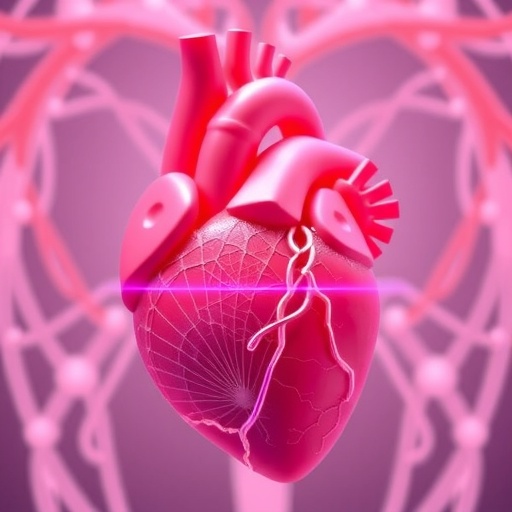In the evolving landscape of medical technology, recent advancements in 3D modeling for congenital heart disease present extraordinary potential. A groundbreaking study authored by Bertelli et al. has highlighted the integration of technologies such as 3D printing, virtual reality (VR), and holograms to improve clinical outcomes for patients suffering from complex heart conditions. The research indicates that these innovative approaches allow for more personalized treatment strategies, enhanced surgical planning, and improved patient education.
Congenital heart disease, a term that encompasses a variety of structural heart defects present at birth, poses significant challenges to healthcare professionals. Traditionally, physicians have relied on two-dimensional imaging modalities such as echocardiograms and X-rays to assess these defects. However, these techniques often fall short in conveying the intricate three-dimensional structure of the heart. The introduction of three-dimensional (3D) modeling technologies revolutionizes this approach by offering a more comprehensive view of cardiac anatomy.
By employing advanced imaging techniques like cardiac MRI and CT, clinicians can generate highly detailed 3D models of a patient’s heart. These digital representations provide a clearer perspective on the spatial relationships between various cardiac structures, allowing medical professionals to visualize conditions that were previously challenging to interpret. The ability to manipulate these models in virtual environments serves as a crucial teaching tool, offering an interactive platform that enhances understanding among healthcare providers.
Moreover, the integration of 3D printing technology further amplifies the advantages of 3D modeling. Surgeons are now able to create physical heart models that replicate the anatomy of specific patients. This tangible representation enables them to rehearse complex surgical procedures before entering the operating room. Preoperative simulations facilitated by these 3D-printed models have the potential to reduce risks associated with surgeries, resulting in better patient outcomes and shorter recovery times.
Virtual reality also plays a pivotal role in the integration of 3D technologies in the medical field. Utilizing VR headsets, healthcare professionals can immerse themselves in the 3D representation of the heart, viewing it from different angles and perspectives. Such immersive experiences not only enhance visualization but also promote collaboration among surgeons, cardiologists, and radiologists. The interactive nature of VR allows multiple specialists to engage in the planning of procedures, thereby fostering informed decision-making based on a collective understanding of the anatomy.
Additionally, the emotional aspect of patient care cannot be overlooked. Afraid and confused patients often struggle to comprehend complex medical conditions, especially when it involves intricate organs like the heart. Through the use of 3D models and VR, patients and their families can visualize their diagnoses, easing anxiety by providing a clearer understanding of the procedures and outcomes. This enhancement in communication can lead to a more trusting patient-provider relationship and, ultimately, an improved experience in the healthcare system.
Holograms represent another frontier in the realm of 3D modeling technologies. Although still in its nascent stages within the medical sphere, holography shows promising potential for displaying 3D images in real-time. This technology enables physicians to project holograms of a patient’s heart in their actual space, facilitating hands-on exploration without invasive procedures. Surgeons can analyze the structure of the heart interactively, gaining insights without the distraction of 2D scans.
Furthermore, the continual advancements in computational power and imaging algorithms contribute to the increasing sophistication of these technologies. The advent of artificial intelligence (AI) in this domain could see enhancements in accuracy and predictive modeling. Machine learning algorithms can analyze vast sets of imaging data, identifying patterns that help predict surgical outcomes and even potential complications. This predictive power stands to transform the way congenital heart diseases are managed.
As we look to the future, the cascading effects of these technologies on the educational landscape must be acknowledged. Medical training programs are beginning to incorporate 3D modeling into their curricula, allowing students to engage with complex cases sooner in their education. Familiarizing young doctors with advanced imaging and 3D visualization techniques can equip them with the skills required to navigate a rapidly evolving healthcare landscape.
Collaboration between academia and industry holds the key to the further advancement of these technologies. Partnerships that spur innovation can lead to the development of more accessible and affordable solutions, enabling broader implementation of these techniques across various healthcare settings. The integration of 3D technology in the management of congenital heart disease is not limited to specialized centers; instead, it has the potential to reach a vast number of patients worldwide.
Importantly, ethical considerations must also be accounted for as these technologies take a more central role in medical practice. The use of personal health data to create individualized models necessitates stringent data privacy measures. Clear guidelines must be established to protect patient information, ensuring that this potent technology is employed responsibly and ethically.
In conclusion, Bertelli et al. have illuminated the exciting possibilities that 3D modeling technologies hold for the future of congenital heart disease treatment. By integrating 3D printing, VR, and holographic imaging into the clinical workflow, healthcare providers can enhance surgical planning and patient education significantly. As these technologies continue to advance, they promise not just to improve outcomes for patients but to transform the entire landscape of how congenital heart diseases are approached and treated.
Subject of Research: 3D modeling technologies for congenital heart disease
Article Title: Advancements in 3D modeling technologies for congenital heart disease: integrating 3D printing, virtual reality, and holograms.
Article References: Bertelli, F., Singh, A., Lam, C.Z. et al. Advancements in 3D modeling technologies for congenital heart disease: integrating 3D printing, virtual reality, and holograms. Pediatr Radiol (2025). https://doi.org/10.1007/s00247-025-06433-w
Image Credits: AI Generated
DOI: https://doi.org/10.1007/s00247-025-06433-w
Keywords: 3D modeling, congenital heart disease, 3D printing, virtual reality, holography, surgical planning, patient education, AI, medical imaging.




